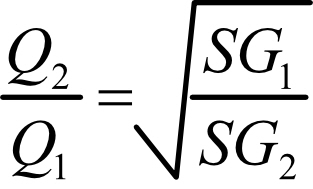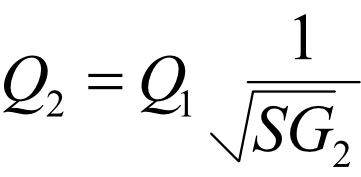Flow rate
Flow rate is the volume of liquid flowing through a nozzle. Any nozzle will produce a certain flow rate at a given pressure differential. The differential pressure is the difference between the pressure of fluid in the pipe just before exit minus the pressure of the vessel it is being sprayed into so it is important to compensate for friction losses and if the fluid is being sprayed into a pressurised vessel.
The flow rate for a given nozzle can be calculated by the following formula:

Q= Flow rate
K = K factor for nozzle
P = Pressure differential at the nozzle
n = Is a constant that depends upon the spray pattern type.
The K factor is a unique constant for that particular nozzle which should be listed in the nozzle data table.
For many nozzles n = 0.5 which means the quotation simply becomes

This is commonly used to apply to all nozzles but it is, in fact, erroneous to do so for some nozzles. In particular non-spiral design full cone nozzles and wide angle full cone nozzles - they will have an 'n' exponent of 0.46 or 0.44.
A further tip is to ensure that the K factor is in the correct units. Whilst it is technically a unitless constant it will depend upon whether metric or imperial units are being used for P and Q. There is a metric K factor and an imperial K factor for each nozzle. So caution needs to be exercised when looking at K factors.
Specific gravity
If the fluid is heavier or lighter than water this too must be compensated for when calculating flow rates. Heavier fluids will experience a lower flow than water and vice versa.

Q1 = Flow rate for a fluid of SG1
Q2 = Flow rate for fluid of SG2
When using nozzle flow rate charts that list water flow rates, one can obtain the flow rates for different fluids by rearranging the equation above and setting SG1 to be 1 (for water) using the Q1 flow rate from the chart.

What is interesting to note is that heavier-than-water fluids will spray less volume of fluid through a spray but the weight of the spray will still be heavier. This can be seen from the equation above as the flow rate (volume) is reduced by a 1/root SG factor where as the fluid weight of that spray will obviously be increased by a factor of SG2.